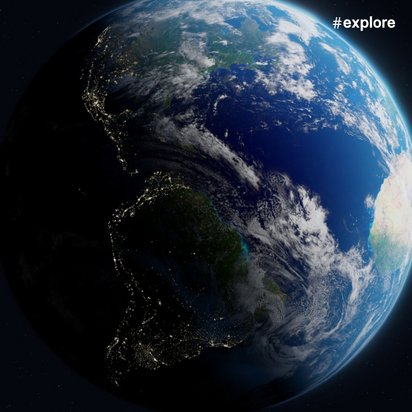Good question, next question
Are all planets really round?
Gravity, centrifugal force, and the largest dog bone in our solar system.

Good question, next question
Gravity, centrifugal force, and the largest dog bone in our solar system.

14 August 2025
If you look at a diagram of our solar system or have the experience of travelling into space in a planetarium, you will see spherical planets, all as perfect and flawless as billiard or ping-pong balls, albeit a bit bigger. But are planets really that spherical? And if so, why?
Greek philosophers such as Pythagoras were the first to come up with the idea that our Earth and the other planets had to be spheres. Aristotle came to this conclusion from the round shadow that the Earth casts over the moon during a lunar eclipse and from the fact that the masts of ships slowly dip below the horizon – which can only be explained by a curved Earth. For him and various philosophers who went before him, the sphere was also considered to be the perfect form. And since the assumption was that the universe had been perfectly ordered and arranged by a divine principle, this added further weight to the argument for a spherical Earth.
The fact that ancient thinkers and natural scientists were not at all wide of the mark has to do with that force which reliably brings us and everything else back down to Earth time and again: gravity. Planets are formed from the gas and dust particles that orbit young stars. These particles attract each other and stick together, forming ever larger clumps as they do so. And the larger these clumps get, the stronger the gravitational pull of these young celestial bodies becomes, with the result that they attract ever more and ever larger pieces of celestial debris.
At the same time, gravitational force, which is directed towards its own centre, increases. Why is this? Well, once a body has reached a certain size, all masses are pulled towards its centre. And because gravity acts evenly on the surrounding material in all directions – rather like the way in which circles of spectators form around street musicians in a marketplace – previously misshapen clumps become rounder and rounder, finally ending up as spheres.
Small celestial bodies, on the other hand, tend to resemble potatoes rather than spheres. Because they are too small and their mass is too low, they do not exert a strong enough gravitational pull to draw their material into a spherical form.
But it doesn't take that much for this to happen. Depending on the matter from which the celestial body is formed, a diameter of just a few hundred kilometres can be enough for it to start assuming spherical proportions. Vesta, the second largest body in the asteroid belt, which measures some 523 kilometres in diameter, has moved beyond the potato stage and is now more reminiscent of a celeriac of gigantic proportions tipped on one side – but even Vesta is not yet a true sphere. The dwarf planet Ceres, which likewise floats around in the asteroid belt and has a diameter of 964 kilometres, does clearly appear to be spherical. In fact, one of the central features that distinguish dwarf planets from asteroids and moons is that they are big enough to form spheres.
So, can we say that the rule of thumb is that the bigger and heavier a celestial body is, the rounder it becomes? In principle, yes – but in practice, not quite. If you take a closer look at our Earth, for example, you will see that it flattens out a bit at the top and bottom. And it is not the only planet which does this.
This is due to another force which acts on planetary bodies. As well as orbiting around their stars, planets also revolve on their own axis. And with rotation, centrifugal force comes into play. Just as it presses screaming children on merry-go-rounds to the outer edge of their seats, so too does centrifugal force pull the mass of a celestial body outward. And because gravity also pulls everything inwards at the same time, you end up with two opposing forces acting on the same body. The result is that planets effectively end up being squeezed. Since the centrifugal force is strongest at the equator, they get a bit fatter here. What emerges is an equatorial bulge, the technical term for this extra planetary girth. At the poles, on the other hand, they flatten out. As a result, our blue planet has 42.7 kilometres more diameter at the equator than it does in the icy realm of penguins and polar bears.
Our Earth has a special feature that makes its surface comparatively bumpy: plate tectonics. The motions of the continental plates press out mountains like the Alps and the Himalayas. With its bumps and dents, our Earth would hopelessly fail the quality test for table tennis or billiard balls. But even if it is not as perfect as the ancient philosophers thought, without its imperfections, we wouldn’t exist – and neither would ping-pong balls, billiard balls or the idea of the perfect spherical form.
This is an article from #explore. #explore is a digital journey of discovery into a world that is rapidly changing. Increasing connectivity, innovative technologies, and all-encompassing digitalization are creating new things and turning the familiar upside down. However, this also brings dangers and risks: #explore shows a safe path through the connected world.